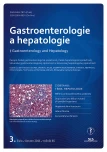Unusual complication of chronic pancreatitis
Authors:
A. Houska 1; F. Závada 1; J. Lacman 2; I. Buřič 2; J. Csomor 1; M. Zavoral 1; P. Frič 1
Authors‘ workplace:
Interní klinika, 1. LF UK a ÚVN Praha2Radiodiagnostické oddělení, ÚVN Praha
1
Published in:
Gastroent Hepatol 2011; 65(3): 154-156
Category:
Clinical and Experimental Gastroenterology: Case Report
Overview
A 52-year-old man with a ten-year history of chronic calcifying pancreatitis of toxo-metabolic etiology was admitted to hospital with an acute exacerbation of chronic pancreatitis. On the day 4 of hospitalization his clinical status was complicated by retroperitoneal bleeding due to the rupture of a splenic artery pseudoaneurysm. The vascular defect was treated by endovascular embolization without need for surgical intervention. Rupture of the splenic artery pseudoaneurysm is a rare but serious complication of chronic pancreatitis with a high mortality rate. As the incidence of this complication is low, there are no specific guidelines for immediate treatment. Endovascular intervention is the first of treatment of choice for hemodynamically stable patients. Its success rate is high; however, so is the risk of re-bleeding. Surgical intervention is indicated in hemodynamically unstable patients after the failure of an endovascular intervention, or in the event of re-bleeding. The extent of surgery depends on the locality of the lesion and on the primary pancreatic affection.
Key words:
chronic pancreatitis – retroperitoneal bleeding – splenic artery pseudoaneurysm – endovascular intervention
Sources
1. Bresler L, Boissel P, Grosdidier J. Major hemorrhage from pseudocysts and pseudoaneurysms caused chronic pancreatitis: surgical therapy. World J Surg. 1991; 15: 649–653.
2. Pitkaranta P, Haapiainen R, Kivisaari L et al. Diagnostic evaluation and aggressive surgical approach in bleeding pseudoaneurysms associated with pancreatic pseudocysts. Scand J Gastroenterol 1991; 26 : 58–64.
3. Tessier DJ, Stone WM, Fowl RJ et al. Clinical features and management of splenic artery pseudoaneurysm: case series and cumulative review of literature. J Vasc Surg 2003; 38 : 969–974.
4. Yeo CJ, Bastidas JA, Lynch-Nyhan A et al. The natural history of pancreatic pseudocysts documented by computed tomography. Surg Gynecol Obstet 1990; 170: 411–417.
5. Balachandra S, Siriwardena AK. Systemic appraisal of the management of the major vascular complications of pancreatitis. Am J Surg 2005; 190 : 489–495.
6. Boudghene F, L‘Hermine C, Bigot JM. Arterial complications of pancreatitis: diagnostic and therapeutic aspects in 104 cases. J Vasc Interv Radiol 1993; 4: 551–558.
7. Singh SC, Giri K, Gupta R et al. Successful management of hepatic artery pseudoaneurysm complicating chronic pancreatits by stenting. World J Gastroenterol 2006; 12 : 5733–5734.
8. Stambo GW, Hallisey MJ, Gallagher JJ Jr. Arteriographic embolization of visceral artery pseudoaneurysms. Ann Vasc Surg 1996; 10 : 476–480.
9. El Hamel A, Parc R, Adda G et al. Bleeding pseudocysts and pseudoaneurysms in chronic pancreatitis. Br J Surg 1991; 78 : 1059–1063.
10. de Perrot M, Berney T, Buhler L et al. Management of bleeding pseudoaneurysms in patients with pancreatitis. Br J Surg 1999; 86 : 29–32.
11. Reber PU, Patel AG, Baer HU et al. Acute hemorrhage in chronic pancreatitis: diagnosis and treatment options including superselective microcoil embolization. Pancreas. 1999; 18 : 399–402.
Labels
Paediatric gastroenterology Gastroenterology and hepatology SurgeryArticle was published in
Gastroenterology and Hepatology

2011 Issue 3
Most read in this issue
- Importance of portosystemic pressure gradient measurement (HVPG) in patients with liver cirrhosis
- Hepatocellular carcinoma – diagnosis and treatment from the medical oncology perspective
- Unusual complication of chronic pancreatitis
- Serum concentration of hyaluronic acid correlates with the degree of fibrosis and portal hypertension
